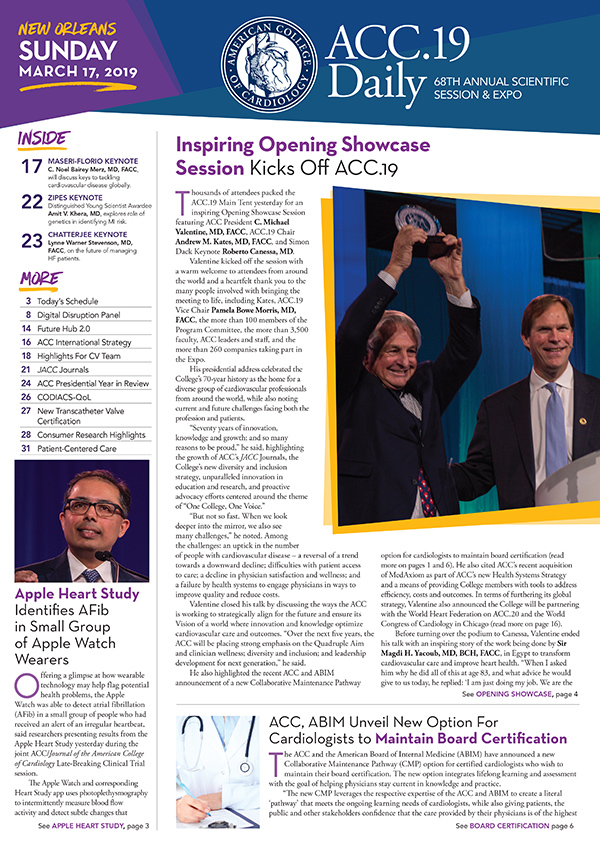ACC Members Living Patient-Centered Care
Being patient-centered is a fundamental Core Value of the ACC. It means advocating on behalf of the cardiovascular patient population; ensuring the safety and needs of cardiovascular patients are central to everything we do; supporting and educating patients and clinicians in the practice of shared decision-making; and encouraging patients to be active members of the care team. ACC.19 Daily asked several ACC members, "How Do You Practice Patient-Centered Care?" in order to learn about how they practice empowering patients in their own clinical settings.
How Do You Practice Patient-Centered Care?
Andrew M. Freeman, MD, FACC, member of ACC's Prevention of Cardiovascular Disease Section Leadership Council.
Besides the usual patient education and involvement in their care plans at every visit, my favorite way to practice patient-centered care is by literally walking side-by-side with my patients. Each month for nearly the last decade, I have been hosting a "Walk with a Doc program." Early on a Saturday morning, I host free coffee and breakfast in a local park followed by an expert speaker (sometimes myself) on a high-yield health topic, and then we walk. We use exercise as medicine and educate the public and our patients about important health topics. The program has steadily grown and inspired people to take health back into their own hands and to use lifestyle medicine to improve their health status. It is rewarding for patient and provider alike, as well as a great way to recharge – after all, directly impacting patients is why I went into medicine in the first place!
Eileen M. Handberg, PhD, ARNP, FACC, chair of ACC's CV Team Section.
As a nurse practitioner working on the inpatient service for an interventional service with a role of facilitating early discharge after interventional procedures, my entire focus is on the patient. I focus on translating procedure results to the patient and family so that they can understand what was done, as well as what therapy and lifestyle changes they will have to implement to help lower their risk for future events. I also think it's important to take into account all the various factors for each patient, including insurance coverage and resources that are not available to help the patient make the most beneficial decisions.
Travis C. Batts, MD, FACC, cardiologist at the U.S. Air Force in San Antonio, TX.
The practice of patient-centered care focuses on three primary areas: engagement, enlightenment and encouragement. A purely paternalistic approach or one that garnishes fear may curb behaviors for a short time; however, after the fear subsides, the deleterious behavior returns. When I engage with my patients on a real and personal level, we both are invested in the proliferation of health. Once invested, I am often surprised at the changes they are willing to make despite years of the same behavior. For example, all of my patients know we are going to have a discussion regarding the impact of diet. In many cases, this is an uncomfortable revelation of what we both know: poor diet contributes to poor health. At these stages, despite both of our engagement and seamless enlightenment, my patient needs to be encouraged. The process is one that has proven both fulfilling and successful at fostering long-term health goals.
Martha Gulati, MD, MS, FACC, editor-in-chief of ACC's CardioSmart.
In my practice, I approach patient-centered care through shared decision-making. It is the patient that matters – and they are at the center of everything my team and I do. While the choices my patients make about how we should approach their treatment plans needs to be an informed decision, I also take into account their values, preferences and ultimately their choices. We need to do more than just ask, 'what is the matter?' but also ask, 'what matters to you?' For me, optimal decision-making ultimately takes into account not only evidence-based information of available options, the provider's knowledge and experience, but also the patient's values and preferences. To the end, ACC's CardioSmart has created shared decision-making tools for physicians and their teams to continue to build the portfolio, since we strongly believe this is the best approach to patient care.
Sandeep Krishnan, MD, FACC, cardiologist at St. John's Clinic in Tulsa, OK.
Patient-centered care is an evolving concept as we move from historically paternalistic decision-making to one that utilizes shared decision-making models. In my practice, I describe my role to patients as their medical guide in their respective journey through the health care system. I tell them that I will give them recommendations but, most importantly, I want to make sure that they know and understand all the options and are able to make an educated decision that most accurately reflects their values and needs. I have received a great deal of positive feedback from these patients, even though they often still ask me to weigh in and provide them a recommendation, which I feel is very much appropriate and part of my job. When I am overseas working in limited-resource settings, practicing in such a manner is infinitely more difficult. However, patient-centered care is a global concept and should not be limited to the developed world. Language and cultural barriers must be considered, which is a major part of providing high-quality, patient-centered care.
Keywords: ACC Publications, ACC Scientific Session Newspaper, ACC Annual Scientific Session, ACC19
< Back to Listings

